| | Early Years and Escalation Fifty years ago, in March 1965, 3,500 U.S. Marines landed in South Vietnam. They were the first American combat troops on the ground in a conflict that had been building for decades. The communist government of North Vietnam (backed by the Soviet Union and China) was locked in a battle with South Vietnam (supported by the United States) in a Cold War proxy fight. The U.S. had been providing aid and advisors to the South since the 1950s, slowly escalating operations to include bombing runs and ground troops. By 1968, more than 500,000 U.S. troops were in the country, fighting alongside South Vietnamese soldiers as they faced both a conventional army and a guerrilla force in unforgiving terrain. Each side suffered and inflicted huge losses, with the civilian populace suffering horribly. Based on widely varying estimates, between 1.5 and 3.6 million people were killed in the war. This photo essay, part one of a three-part series, looks at the earlier stages of U.S. involvement in the Vietnam War, as well as the growing protest movement, between the years 1962 and 1967. 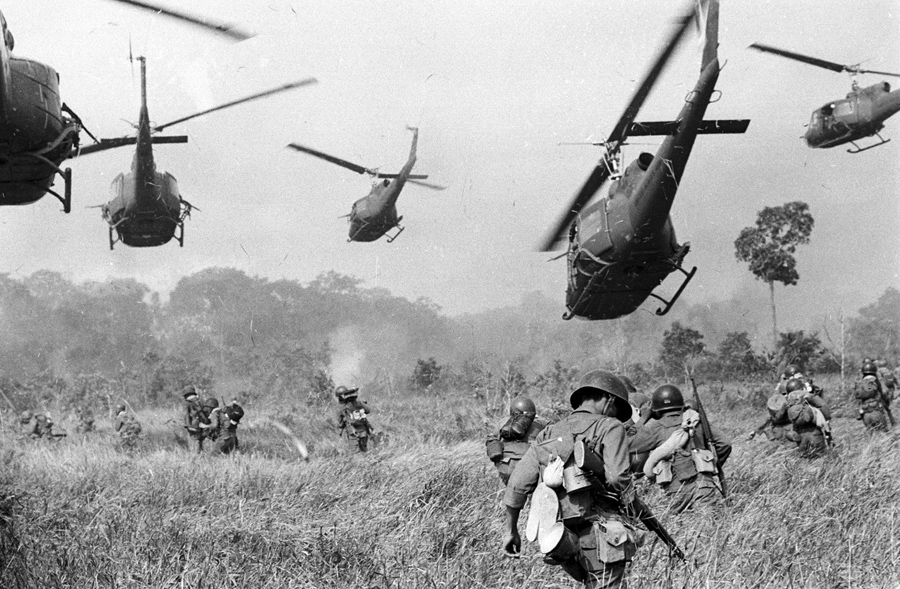 -
Hovering U.S. Army helicopters pour machine gun fire into a tree line to cover the advance of South Vietnamese ground troops in an attack on a Viet Cong camp 18 miles north of Tay Ninh, near the Cambodian border, in March of 1965. For years, the U.S. government measured success by how many enemy forces it killed rather than such traditional goals as controlling cities or territory. Yet even then, it seemed a dubious strategy. Philip Caputo, a U.S. Marine who went on to write the classic Vietnam memoir A Rumor of War, observes in our documentary that, "It certainly seemed a peculiar way to try to measure victory, and I thought … it was kind of morally corrosive." Yet for years, the U.S. government believed that if we killed enough of them, the North Vietnamese would just give up. This was a strategic miscalculation of enormous consequences because, as one soldier put it, "We couldn't kill North Vietnamese soldiers faster than North Vietnamese mothers could give birth." Ho Chi Minh knew that he could outwait us. He died in 1969, but his country did outwait us, and eventually defeated us. Of course, the irony of the Vietnam War was that the United States won nearly every battle of consequence against the North Vietnamese Army, often at a rate of 10 Communist casualties for every American. Our soldiers fought gallantly, courageously and professionally, and they believed in their cause. They constituted an outstanding fighting force until they became demoralized by the realization that the home front no longer supported their mission. The Vietnam War took the lives of more than 58,000 Americans and at least 1.5 million Vietnamese. For those who put their boots on the ground, the war's end did not bring a conclusion. So our documentary ends not with a conclusion but with the voices of the soldiers themselves. Retired Army colonel Fred Spaulding says, "It's unbelievable how vicious you can be against another human being when you have to be. Then they put you on a plane. Everybody expects you to be the same way that you used to be: 'Little Johnny went off to war.' Well, Little Johnny isn't Little Johnny anymore." Retired brigadier general John Bahnsen says, "We were proud of our service. We were proud of what we did. We never lost a fight. And we gave it our best shot." So they did. Half a century later, let us continue to honor them for it. -
-
An American officer serving with the South Vietnam forces poses with group of Montagnards in front of one of their provisionary huts in a military camp in central Vietnam on November 17, 1962. They were brought in by government troops from a village where they were used as labor force by communist Viet Cong forces. The Montagnards, dark-skinned tribesmen numbering about 700,000, live in the highlands of central Vietnam. The government was trying to win their alliance in its war -
with the Viet Cong. 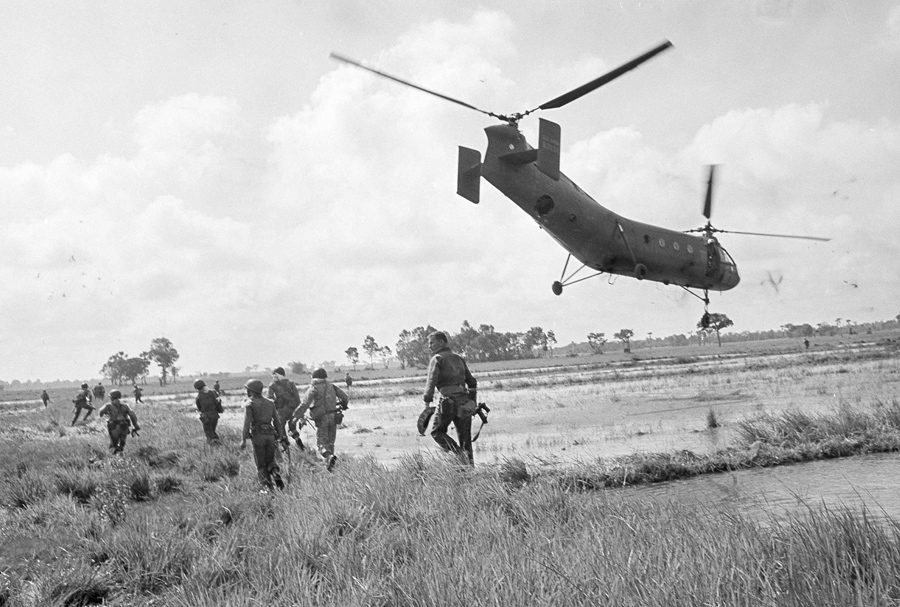 -
Vietnamese airborne rangers, their two U.S. advisers, and a team of 12 U.S. Special Forces troops set out to raid a Viet Cong supply base 62 miles northwest of Saigon, on August 6, 1963. As the H-21 helicopters hovered six feet from the ground to avoid spikes and wires and under sniper fire, the troops jumped out to attack. # PHOTO -
A South Vietnamese Marine, severely wounded in a Viet Cong ambush, is comforted by a comrade in a sugar-cane field at Duc Hoa, about 12 miles from Saigon, on August 5, 1963. A platoon of 30 Vietnamese Marines was searching for communist guerrillas when a long burst of automatic fire killed one Marine and wounded four others.# 
-
Napalm air strikes raise clouds into gray monsoon skies as houseboats glide down the Perfume River toward Hue in Vietnam on February 28, 1963, where a battle for control of the old Imperial City ended with a Communist defeat. Firebombs were directed against a village on the outskirts of Hue. # -
Thich Quang Duc, a Buddhist monk, burns himself to death on a Saigon street on June 11, 1963, to protest alleged persecution of Buddhists by the South Vietnamese government. President Ngo Dình Diem, part of the Catholic minority, had adopted policies that discriminated against Buddhists and gave high favor to Catholics. # -
Flying low over the jungle, an A-1 Skyraider drops 500-pound bombs on a Viet Cong position below as smoke rises from a previous pass at the target, on December 26, 1964. # 
-
Partially covered, a dying Viet Cong guerrilla raises his hands as South Vietnamese Marines search palm groves near Long Binh in the Mekong Delta, on February 27, 1964. The guerrilla died in a foxhole following a battle between a battalion of South Vietnamese Marines and a unit of Viet Cong. # 
-
As U.S. "Eagle Flight" helicopters hover overhead, South Vietnamese troops wade through a rice paddy in Long An province during operations against Viet Cong guerrillas in the Mekong Delta, in December of 1964. The "Eagle Flight" choppers were loaded with Vietnamese airborne troops who were dropped in to support ground forces at the first sign of enemy contact. # -
A father holds the body of his child as South Vietnamese Army Rangers look down from their armored vehicle on March 19, 1964. The child was killed as government forces pursued guerrillas into a village near the Cambodian border. # -
-
Marines wade ashore with heavy equipment at first light at Red Beach near Da Nang in Saigon on April 10, 1965. # 
-
With the persuasion of a Viet Cong-made spear pressed against his throat, a captured Viet Cong guerrilla decided to talk to interrogators, telling them of a cache of Chinese grenades on March 28, 1965. He was captured with 13 other guerrillas and 17 suspects when two Vietnamese battalions overran a Viet Cong camp about 15 miles southwest of Da Nang air force base. # -

-
Thousands attend a rally on the grounds of the Washington Monument in Washington on April 17, 1965, to hear Ernest Gruening, a Democratic senator from Alaska, and other speakers discuss U.S. policy in Vietnam. The rally followed picketing of the White House by students demanding an end to Vietnam fighting. # -
-
A nurse attempts to comfort a wounded U.S. Army soldier in a ward of the 8th army hospital at Nha Trang in South Vietnam on February 7, 1965. The soldier was one of more than 100 who were wounded during Viet Cong attacks on two U.S. military compounds at Pleiku, 240 miles north of Saigon. Seven Americans were killed in the attacks. # -
-
Flag-draped coffins of eight American Servicemen killed in attacks on U.S. military installations in South Vietnam, on February 7, are placed in transport plane at Saigon, February 9, 1965, for return flight to the United States. Funeral services were held at the Saigon Airport with U.S. Ambassador Maxwell D. Taylor and Vietnamese officials attending. # 
-
Injured Vietnamese receive aid as they lie on the street after a bomb explosion outside the U.S. embassy in Saigon, Vietnam, on March 30, 1965. Smoke rises from wreckage in background. At least two Americans and several Vietnamese were killed in the bombing. # 
-
Four "Ranch Hand" C-123 aircraft spray liquid defoliant on a suspected Viet Cong position in South Vietnam in September of 1965. The four specially equipped planes covered a 1,000-foot-wide swath in each pass over the dense vegetation. # -
A Vietnamese battalion commander, Captain Thach Quyen, left, interrogates a captured Viet Cong suspect on Tan Dinh Island, Mekong Delta, in 1965. # -
A strategic air command B-52 bomber with externally mounted, 750-pound bombs heads toward its target about 56 miles northwest of Saigon near Tay Ninh on November 2, 1965. # 
-
General William Westmoreland talks with troops of first battalion, 16th regiment of 2nd brigade of U.S. First Division at their positions near Bien Hoa in Vietnam, in 1965.# 
-
Flares from planes light a field covered with the dead and wounded of the ambushed battalion of the U.S. 1st Cavalry Division in the Ia Drang Valley, Vietnam, on November 18, 1965, during a fierce battle that had been raging for days. Units of the division were battling to hold their lines against what was estimated to be a regiment of North Vietnamese soldiers. Bodies of the slain soldiers were carried to this clearing with their gear to await evacuation by helicopter. # -
A Viet Cong fighter in Vietnam in an undated photo # 
-
A U.S. Marine, newly arrived in South Vietnam on April 29, 1965, drips with perspiration while on patrol in search of Viet Cong guerrillas near Da Nang air base. American troops found 100-degree temperatures a tough part of the job. General Wallace M. Greene Jr., a Marine Corps commandant, after a visit to the area, authorized light short-sleeved uniforms as aid to troops’ comfort. # -
In Berkeley-Oakland City, California, demonstrators march against the war in Vietnam in December of 1965. # 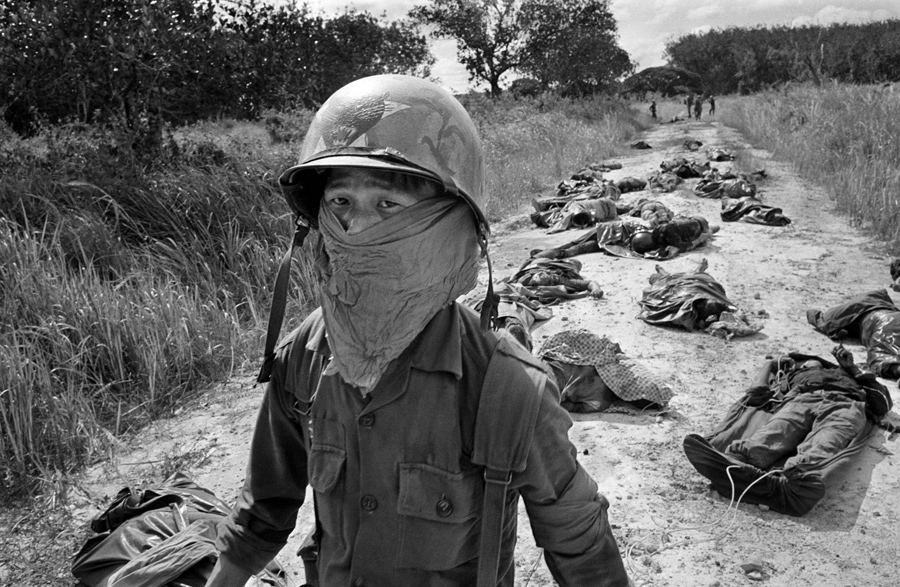
-
A Vietnamese litter bearer wears a face mask to keep out the smell as he passes the bodies of U.S. and Vietnamese soldiers killed in fighting against the Viet Cong at the Michelin rubber plantation, about 45 miles northeast of Saigon, on November 27, 1965. # -
Pedestrians cross the destroyed Hue Bridge in Hue, Vietnam, in an undated photo. # -
Wounded and shocked civilian survivors of Dong Xoai crawl out of a fort bunker on June 6, 1965, where they survived murderous ground fighting and air bombardments of the previous two days. # 
-
A U.S. Air Force Douglas A-1E Skyraider drops a white phosphorus bomb on a Viet Cong position in South Vietnam in 1966. # -
A Vietnamese girl, 23 years old, was captured by an Australian patrol 30 feet below ground at the end of a maze of tunnels some 10 miles west of the headquarters of the Australian task force (40 miles southeast of Saigon). The woman was crouched over a World War II radio set. About seven male Viet Cong took off when the Australians appeared—but the woman remained and appeared to be trying to conceal the radio set. She was taken back to the Australian headquarters where she told under sharp interrogation (which included a "waterprobe"; see her wet clothes after the interrogation) that she worked as a Viet Cong nurse in the village of Hoa Long and had been in the tunnel for 10 days. The Australians did not believe her because she seemed to lack any medical knowledge. They thought that she may have possibly been the leader of the political cell in Long Hoa. She was being led away after interrogation, clothes soaked from the "waterprobe" on October 29, 1966. # -
Left: Pilot Leslie R. Leavoy in flight with other jets in the background above Vietnam in 1966. Right: Army nurse 2nd Lieutenant Roberta “Bertie” Steele in South Vietnam, on February 9, 1966. # -
Women and children crouch in a muddy canal as they take cover from intense Viet Cong fire at Bao Trai, about 20 miles west of Saigon, on January 1, 1966. Paratroopers, background, of the U.S. 173rd Airborne Brigade escorted the South Vietnamese civilians through a series of firefights during the U.S. assault on a Viet Cong stronghold. # 
-
A napalm strike erupts in a fireball near U.S. troops on patrol in South Vietnam in 1966. # 
-
A Marine, top, wounded slightly when his face was creased by an enemy bullet, pours water into the mouth of a fellow Marine suffering from heat during Operation Hastings along the demilitarized zone between North and South Vietnam on July 21, 1966. # -
-
Left: A Vietnamese child clings to his bound father who was rounded up as a suspected Viet Cong guerrilla during “Operation Eagle Claw” in the Bong Son area, 280 miles northeast of Saigon on February 17, 1966. The father was taken to an interrogation camp with other suspects rounded up by the U.S. 1st air cavalry division. Right: The body of an American paratrooper killed in action in the jungle near the Cambodian border is raised up to an evacuation helicopter in War Zone C, Vietnam, in 1966. # 
-
The singing group the "Korean Kittens" appear on stage at Cu Chi, Vietnam, during the Bob Hope USO Christmas show, to entertain U.S. troops of the 25th Infantry Division. # -
A grim-faced U.S. Marine fires his M60 machine gun, concealed behind logs and resting in a shallow hole, during the battle against North Vietnamese regulars for Hill 484, just south of the demilitarized zone, on October 10, 1966. After three weeks of bitter fighting, the 3rd battalion of the 4th Marines took the hill the week of October 2. # -
Lieutenant Commander Donald D. Sheppard, of Coronado, California, aims a flaming arrow at a bamboo hut concealing a fortified Viet Cong bunker on the banks of the Bassac River, Vietnam, on December 8, 1967. # -
-
A U.S. Marine CH-46 Sea Knight helicopter comes down in flames after being hit by enemy ground fire during Operation Hastings, just south of the demilitarized zone between North and South Vietnam, on July 15, 1966. The helicopter crashed and exploded on a hill, killing one crewman and 12 Marines. Three crewmen escaped with serious burns. # -
A man brews tea while a U.S. Marine examines a pinup in Vietnam in September of 1967. # 
-
A trooper of the U.S. 1st cavalry division aims a flamethrower at the mouth of cave in An Lao Valley in South Vietnam, on April 14, 1967, after the Viet Cong group hiding in it were warned to emerge. # -
Sergeant Ronald Payne, 21, of Atlanta, Georgia, emerges from a Viet Cong tunnel holding his silencer-equipped revolver with which he fired at guerrillas fleeing ahead of him underground. Payne and others of the 196th light infantry brigade probed the massive tunnel in Hobo Woods, South Vietnam, on January 21, 1967, and found detailed maps and plans of the enemy. The infantrymen who explored the complex are known as “Tunnel Rats.” They were called out of the tunnels on January 21, and nauseating gas was pumped in. # -
Military police, reinforced by Army troops, throw back anti-war demonstrators as they tried to storm a mall entrance doorway at the Pentagon in Washington, D.C., on October 21, 1967. # 
-
Rick Holmes of C company, 2nd battalion, 503rd infantry, 173rd airborne brigade, sits down on January 3, 1966, in Vietnam. # 
-
U.S. Navy Douglas A-4E Skyhawks from Attack Squadrons VA-163 Saints and VA-164 Ghost Riders attack the Phuong Dinh railroad bypass bridge, 10 kilometers north of Thanh Hoe, North Vietnam, on September 10, 1967. Note the attacking Skyhawk in the lower right and one directly left of the explosions on the bridge. # 
-
U.S. soldiers of the 3rd Brigade, 4th Infantry Division, look on a mass grave of enemy combatants after a day-long battle against the Viet Cong 272nd Regiment, about 60 miles northwest of Saigon, in March of 1967. U.S. military command reported 423 Communist forces dead, with American losses at 30 dead, 109 wounded, and three missing. # -
U.S. troops of the 7th and 9th divisions wade through marshland during a joint operation on South Vietnam's Mekong Delta, in April of 1967. # | | Then later in early 1968, North Vietnamese troops and the Viet Cong launched the largest battle of the Vietnam War, attacking more than 100 cities simultaneously with more than 80,000 fighters. After brief losses, U.S. and South Vietnamese forces regained lost territory, and dealt heavy losses to the North. Tactically, the offensive was a huge loss for the North, but it marked a significant turning point in public opinion and political support, leading to a drawdown of U.S. troop involvement, and eventual withdrawal in 1973. This photo essay, part two of a three-part series, covers the war years between 1968 and 1975. 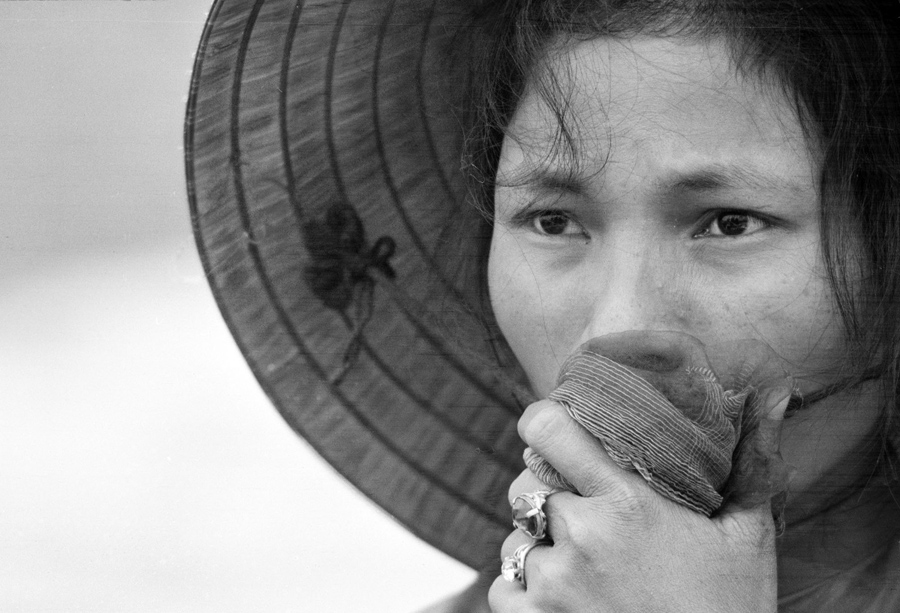 -
A young South Vietnamese woman covers her mouth as she stares into a mass grave where victims of a reported Viet Cong massacre were being exhumed near Dien Bai village, east of Hue, in April of 1969. The woman's husband, father, and brother had been missing since the Tet Offensive, and were feared to be among those killed by Communist forces. # -
U.S. air policemen take cover and leave their jeep as they come under sniper fire near Da Nang Airbase in Vietnam on January 30, 1968, after it was hit by a rocket barrage. Flares light up the Da Nang area to make it easier to spot infiltrating guerrillas. # 
-
Battle of Saigon, First Offensive, on February 10, 1968 # 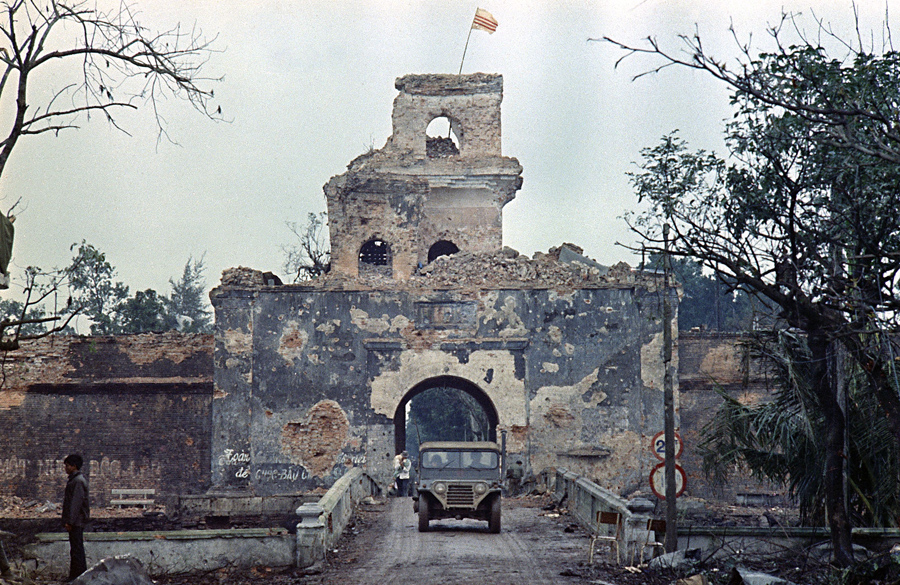
-
The flag of the Republic of Vietnam flies atop a tower of the main fortified structure in the old citadel as a jeep crosses a bridge over a moat in Hue during the Tet Offensive, February 1968. # 
-
A dead civilian lies nearby as a young Vietnamese boy shields his ears from gunfire blasts and runs for cover on a Da Nang street on January 31, 1968. # AP -
-
U.S. Marines and Vietnamese troops move through the grounds of the Imperial Palace in the old citadel area of Hue, Vietnam, on February 26, 1968, after seizing it from Communist hands. The heavy damage was the result of the artillery, air, and mortar pounding the area received for 25 days while the Viet Cong/NVA held the area. # -
With dead U.S. soldiers in the foreground, U.S. military police take cover behind a wall at the entrance to the U.S. Consulate in Saigon on the first day of the Tet Offensive, January 31, 1968. Viet Cong guerrillas had invaded the grounds of the U.S. embassy compound in the earliest hours of the coordinated Communist offensive. # -
South Vietnamese combat police advance toward a burning building in northeastern Saigon on February 19, 1968, as they battle Viet Cong forces who had occupied several city blocks in the area. # -
A Viet Cong prisoner sits next to corpses of 11 of his slain fellow guerrillas after a street fight in Saigon-Cholon on February 11, 1968. In the background are Vietnamese Marines that defeated a Viet Cong platoon holed up in the residential area. The prisoner was later taken out for interrogation. # -
-
The South Vietnamese General Nguyen Ngoc Loan, chief of the national police, fires his pistol into the head of suspected Viet Cong officer Nguyen Van Lem (also known as Bay Lop) on a Saigon street on February 1, 1968, early in the Tet Offensive. Lem was suspected of commanding a death squad which had targeted South Vietnamese police officers that day. The fame of this photo led to a life of infamy for Nguyen Ngoc Loan, who quietly moved to the United States in 1975, opening a pizza shop in Virginia. # -
Assault boats in the Mobile Riverine Force of the U.S. 9th Infantry Division glide along the My Tho River, an arm of the Mekong Delta near Dong Tam, 35 miles southwest of Saigon, on March 15, 1968. # -
Police struggle with anti-Vietnam War demonstrators outside the Embassy of the United States in Grosvenor Square, London, on March 17, 1968. # -
Marine Lance Corporal Roland Ball of Tacoma, Washington, wearing his flak vest, starts the day off with a shave in a trench at the Khe Sanh Base in Vietnam on March 5, 1968, which was surrounded by North Vietnamese regulars. Ball uses a helmet as a sink and a rear-view mirror taken from a military vehicle. # -
-
Vietnamese women on the streets of Saigon, April 1968 # -
The bodies of U.S. Marines lie half buried on Hill 689, about two-and-a-half miles west of Khe Sanh, in April of 1968. Fellow Marines stand guard in the background after battling entrenched North Vietnamese troops for the hill. # -
As fellow troopers aid wounded comrades, the first sergeant of A Company, 101st Airborne Division, guides a medevac helicopter through the jungle foliage to pick up casualties suffered during a five-day patrol near Hue, in April of 1968. # -
Smoke rises from the southwestern part of Saigon on May 7, 1968, as residents stream across the bridge leaving into the capital to escape heavy fighting between the Viet Cong and South Vietnamese soldiers. # -
-
Evidence of violence in the second offensive of the Vietnam War, north of Saigon, in May of 1968 # -
A U.S. trooper runs past a burning building in Saigon in June of 1968. # -
U.S. President Lyndon B. Johnson listens to a tape recording from his son-in-law Captain Charles Robb at the White House on July 31, 1968. Robb was a U.S. Marine Corps company commander in Vietnam at the time. Robb was later awarded the Bronze Star and, after returning home, became governor of Virginia in 1982, and later a senator for the same state. # -
Two napalm drops explode just outside Katum, a U.S. Special Forces camp about 60 miles northwest of Saigon on August 28, 1968. The napalm was used when Viet Cong attacked the camp. # -
-
A U.S Marine with several days of beard growth sits in a helicopter after being picked up from the landing zone near Con Thein on the southern edge of the demilitarized zone in South Vietnam on July 18, 1968. His unit had just been relieved of duty after patrolling the region around the DMZ. # -
Flying 100 feet above the jungle hills west of Hue, five bulky C-123 "providers" cut loose a spray of chemical defoliant on August 14, 1968. The planes are flown by U.S. air force crews who have nicknamed themselves the "ranch hands." The aircraft are specially equipped with huge 1,000-gallon tanks holding 11,000 pounds of herbicide.U.S. planes dropped millions gallons of chemical defoliant on Vietnam over the course of the war. # -
Marines prepare their 105-mm Howitzers for action at the end of a day in which this dense jungle area west of Hue was chopped down and molded into a fire-support base for a sweep of the area on February 18, 1969. Troops used explosives and earth-moving equipment to carve out the gun pits and bunkers which by nightfall became a fire-support base. # -
A Cobra helicopter gunship pulls out of a rocket and strafing attack on a Viet Cong position near Cao Lanh in the Mekong Delta on January 22, 1969. Large craters caused by air and artillery strikes brought in on the area can be seen near the white explosion. # -
-
FBI agents carry Vietnam War draft resister Robert Whittington Eaton, 25, from a dwelling in Philadelphia on April 17, 1969, where Eaton had chained himself to 13 young men and women. The agent leading the way pushed one of the group who tried to block path to the sidewalk. At least six young persons were taken away with Easton. # Warren M. Winterbottom/AP -
A trooper of the 101st Airborne Division attempts to save the life of a buddy at Dong Ap Bia Mountain, near South Vietnam's A Shau Valley on May 19, 1969. The man was seriously wounded in the last of repeated attempts by U.S. forces to capture enemy positions there. # -
A GI gets a closeup photo as President Nixon meets with troops of the 1st Infantry Division at Di An, 12 miles northeast of Saigon, on his eighth visit to South Vietnam and his first as president, on July 30, 1969. # -
Marine Lance Corporal David L. Cruz tunes into the latest news on the Apollo moon shot on a helmet-mounted transistor radio while standing guard at Da Nang's Marble Mountain, on July 17, 1969. In background is a tall Buddhist figure found in many limestone caves of the mountain. # -
-
Demonstrators listen to a performer in Central Park on Moratorium Day, October 15, 1969. Moratorium Day was a mass demonstration and teach-in staged across the United States, in protest against continued American involvement in Vietnam. # -
Three shirtless U.S. soldiers advance through the Mimot rubber plantation in the Fishhook region of Cambodia, on May 4, 1970, taking aim at a fleeing suspect. The rubber plantation, one of the largest in Indochina, had been in operation until just a few days earlier. # -
A GI of the U.S. 199th light infantry brigade walks through bodies laid out just outside the barbed wire perimeter of U.S. firebase crown in Cambodia on May 14, 1970. Fifty North Vietnamese were killed and only four Americans wounded when the North Vietnamese, presumably thinking the firebase already abandoned, walked into an ambush by the American defenders. # -
Vietnamese and Cambodian refugees crowd a U.S. helicopter which evacuated them from immediate combat zone of the U.S.-Vietnamese incursion into Cambodia on May 5, 1970. They were taken to a refugee reception center at the Katum Special Forces camp in South Vietnam, six miles from the Cambodian border. # -
-
The Ohio National Guard moves in on rioting students at Kent State University in Kent, Ohio, on May 4, 1970. Four persons were killed and eleven wounded when National Guardsmen opened fire. # -
Fourteen-year-old Mary Ann Vecchio screams over the body of 20-year-old Kent State student Jeffrey Miller after he was shot by the Ohio National Guard during a protest against the U.S. invasion of Cambodia during the Vietnam War on May 4, 1970. # -
In this photo taken from video, soldiers in fire-support base Aries, a small clearing in the jungles of War Zone D, 50 miles from Saigon, smoke marijuana using the barrel of a shotgun they nicknamed "Ralph," to get high on November 13, 1970. # -
U.S. artillerymen relax under a crudely made peace flag at the Laotian border in 1971. The gunners were giving covering fire for South Vietnamese troops operating inside Laos. # -
-
South Vietnamese troopers test fire flame throwers mounted atop APCs prior to moving out on operation west of Krek, Cambodia, on November 28, 1971. # -
South Vietnamese Marines check the bodies of dead soldiers for cigarettes near My Chanh, new government defense line 20 miles north of Hue, on May 5, 1972. The soldiers were killed during fighting when Quang Tri City was abandoned. # -
Bombs with a mixture of napalm and white phosphorus jelly dropped by Vietnamese AF Skyraider bombers explode across Route 1, amid homes and in front of the Cao Dai Temple in the outskirts of Trang Bang, on June 8, 1972. In the foreground are Vietnamese soldiers and news and cameramen from various international news organizations who watch the scene. # -
South Vietnamese forces follow after terrified children, including 9-year-old Kim Phuc, center, as they run down Route 1 near Trang Bang after an aerial napalm attack on suspected Viet Cong hiding places, on June 8, 1972. A South Vietnamese plane accidentally dropped its flaming napalm on South Vietnamese troops and civilians. The terrified girl had ripped off her burning clothes while fleeing. The children from left to right are: Phan Thanh Tam, younger brother of Kim Phuc, who lost an eye, Phan Thanh Phouc, youngest brother of Kim Phuc, Kim Phuc, and Kim's cousins Ho Van Bon and Ho Thi Ting. Behind them are soldiers of the Vietnam Army 25th Division. # -
-
La Vang, town south of Quang Tri City, on July 6, 1972 # -
A beheaded statue of an American soldier stands next to a bombed-out theater near the district town of Cu Chi, northwest of Saigon, on December 13, 1972. The statue was placed by troops of the U.S. 25th Infantry Division before they were withdrawn from Vietnam two years earlier. Its head was lost in the explosion that destroyed the theater in background. # -
A South Vietnamese widow cries as a bell at a Saigon Buddhist pagoda tolls the ceasefire at 8 a.m., on Sunday, January 28, 1973, Saigon time. The United States had begun drastically reducing forces in the country, and, following the Paris Peace Accords of 1973, the last remaining American troops withdrew in March of 1973. # -
A bon voyage banner stretches overhead in Da Nang, South Vietnam, as soldiers march down a street following a farewell ceremony for some of the last U.S. troops in the country's northern military region, on March 26, 1973. # -
-
The released prisoner of war Lieutenant Colonel Robert L. Stirm is greeted by his family at Travis Air Force Base in Fairfield, California, as he returns home from the Vietnam War, March 17, 1973. In the lead is Stirm's daughter Lori, 15; followed by son Robert, 14; daughter Cynthia, 11; wife Loretta and son Roger, 12. This famous photo, also called "Burst of Joy," won a Pulitzer Prize in 1974. The happy scene depicted here was not to last, however. Stirm, after spending five years in captivity, had received a "Dear John" letter from his wife Loretta, just three days before returning home. They divorced in 1974. # -
A refugee clutches her baby as a government helicopter gunship carries them away near Tuy Hoa, 235 miles northeast of Saigon on March 22, 1975. They were among thousands fleeing from recent Communist advances. With U.S. forces out of the country, North Vietnamese troops tested South Vietnamese defenses (and the willingness of the U.S. to return to the fight) starting in 1974, and began capturing territory. # -
The Fall of Saigon. Fleeing advancing North Vietnamese forces, mobs of South Vietnamese civilians scale the 14-foot wall of the U.S. embassy in Saigon, April 29, 1975, trying to reach evacuation helicopters as the last Americans departed from Vietnam. # -
A cluster of South Vietnamese marines, some of whom unable to swim, hold onto inner tubes and empty plastic containers as buddies throw them a line to pull them aboard a navy LST off China Beach at Danang as they fled the port city in April of 1975. # -
-
A North Vietnamese tank rolls through the gate of the Presidential Palace in Saigon, April 30, 1975, signifying the fall of South Vietnam. The Socialist Republic of Vietnam was formed in 1976, uniting North and South. Millions of South Vietnamese were sent to reeducation camps, millions more fled the country on their own, leading to the Indochina refugee crisis that lasted another quarter of a century. # | |








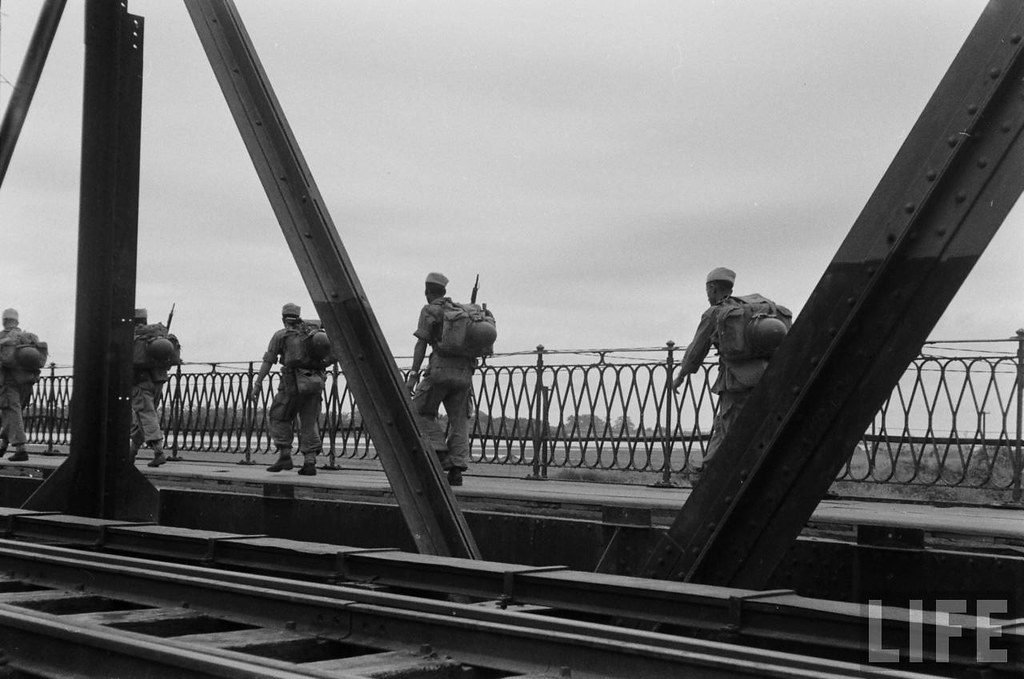

















































































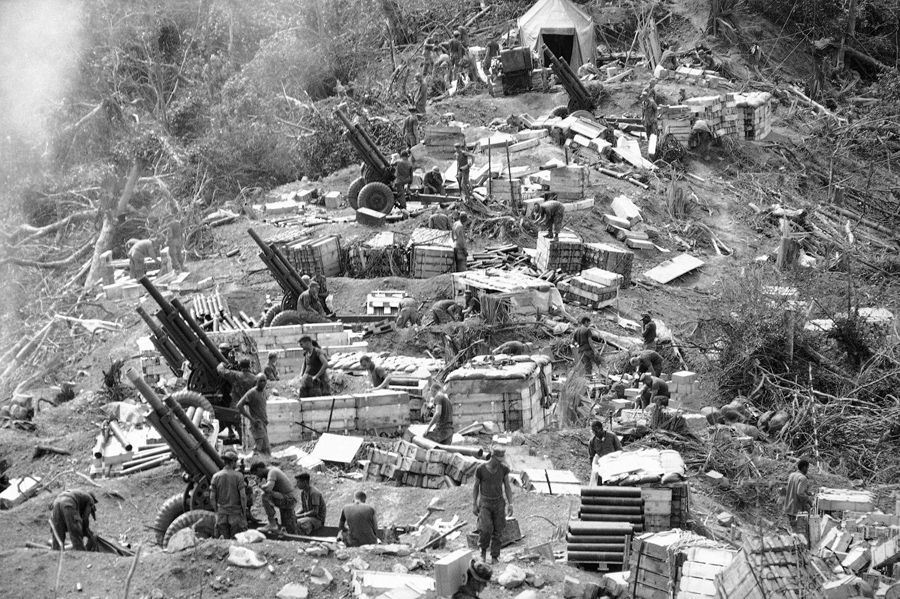
























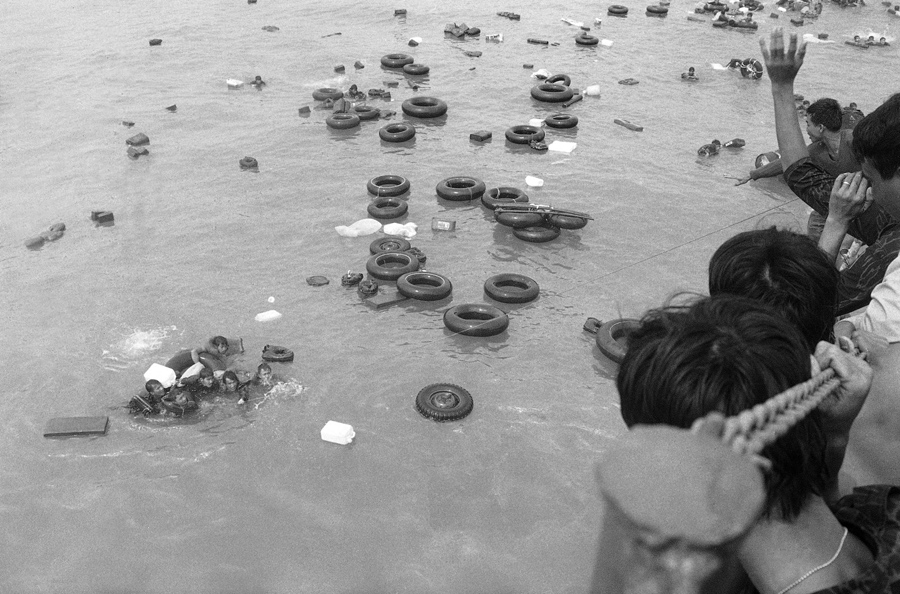

No comments:
Post a Comment